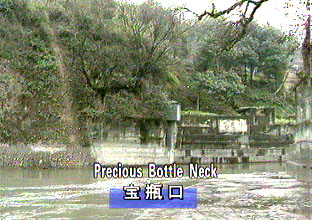 |
|
The Du River Dyke  |
| CCTV.COM 2002-05-23 14:05:22 |
|
 Water conservancy projects were of vital importance in ancient China when agriculture was the foundation of the country. In ancient times, the Chinese nation began to build water conservancy projects on a large scale. Water conservancy projects were of vital importance in ancient China when agriculture was the foundation of the country. In ancient times, the Chinese nation began to build water conservancy projects on a large scale.
The Du River Dyke is situated about 50 kilometres northwest of Chengdu City, Sichuan Province. The Minjiang River rising in the Minshan Mountains had a great flow of water and a sheer drop in elevation. When it reached the Du River Dyke, the swift flow of the river slowed down suddenly. Huge quantities of silt and pebbles it had carried were deposited in the riverbed. The river course was silted up. When torrential water rushed down the mountains, the Minjiang River overflowed its banks and caused serious floods on the Chengdu Plain. When the rainfall was not plentiful, the flow of water in the Minjiang River would decrease, aggravating the drought on the Western Sichuan Plain.
In 256 B.C., Li Bing was appointed governor of Sichuan. To conquer the floods of the Minjiang River, he trekked upstream until he reached the area of the present-day Aba (阿壩) Zang Autonomous Prefecture. He got a lot of hydrological data on the Minjiang River. Then he began to build the Du River Dyke.
 The Du River Dyke system consists of the Fish Mouth, the Sand-flying Dyke and the Precious Bottle Neck. The Du River Dyke system consists of the Fish Mouth, the Sand-flying Dyke and the Precious Bottle Neck.
The Fish Mouth is a diversion dam built of pebbles. It divides the Minjiang River into the inner river and the outer river.
The water of the inner river flows through the Precious Bottle Neck to irrigate 200,000 hectares of farmland around Chengdu.
The outer river was designed mainly to release floodwater.
The Sand-flying Dyke between the Fish Mouth and the Precious Bottle Neck is an overflow dyke. When there is too much water in the inner river, the surplus water brims over the Sand-flying Dyke and flows into the outer river.
The Precious Bottle Neck, dug out of a mountain, is the conduit through which the inner river water flows to the irrigated area.
After the Du River Dyke was completed, Li Bing composed the rhyme easy for memory: "Dredge the riverbed when the water is deep and build low dykes when the water is low". It contains the guiding principle of dredging the waterways in ancient China.
The Du River Dyke serves the purposes of navigation, flood control, log floating and urban water supply. The trinity of the Fish Mouth, the Sand-flying Dyke and the Precious Bottle Neck keeps an effective control of water flowing into the inner river. In case of drought, the Du River Dyke channels water into the fields. If waterlogging occurs, the floodwater can be diverted. With the completion of the Du River Dyke, both floods and droughts were brought under control and famine years were gone. The Chengdu Plain became "a land of abundance".
The Du River Dyke, a great water conservancy project built in ancient times, has been in use for more than 2,000 years. It is a miracle in the world history of water conservancy. The credit was due to our ancestors who had a high regard for nature and did not try to dictate to nature in building water conservancy projects.
|
|
|
|
|
|
|
 |









